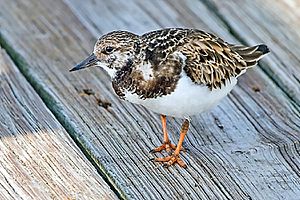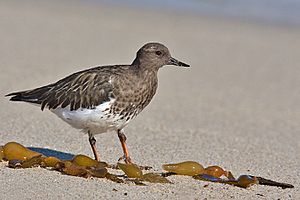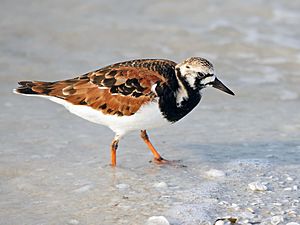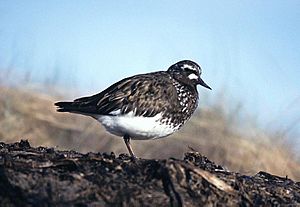Turnstone facts for kids
Turnstones are two types of birds that belong to a group called Arenaria. They are part of the sandpiper family, known as Scolopacidae. These birds are close relatives of other sandpipers, like the calidrids.
Quick facts for kids Turnstone |
|
|---|---|
 |
|
| Ruddy turnstone in nonbreeding plumage | |
 |
|
| Black turnstone in winter plumage | |
| Scientific classification |
|
| Kingdom: | Animalia |
| Phylum: | Chordata |
| Class: | Aves |
| Order: | Charadriiformes |
| Family: | Scolopacidae |
| Subfamily: | Arenarinae |
| Genus: | Arenaria Brisson, 1760 |
| Type species | |
| Tringa interpres Linnaeus, 1758
|
|
| Species | |
Contents
What Are Turnstones?
The name Arenaria was given to these birds by a French zoologist named Mathurin Jacques Brisson in 1760. The word arenaria comes from Latin and means "inhabiting sand." This name fits them well because they often live near sandy areas.
There are two main types of turnstones:
- the ruddy turnstone (Arenaria interpres)
- the black turnstone (Arenaria melanocephala)
How Turnstones Look
Both turnstones are medium-sized waders. Waders are birds that walk in shallow water or on wet ground to find food. Turnstones are usually about 20 to 25 centimeters (8 to 10 inches) long. Their wings can spread out to about 50 to 60 centimeters (20 to 24 inches). They weigh between 110 and 130 grams (about 4 to 4.5 ounces).
They have a strong, stocky body. Their bills are short, slightly curved upwards, and shaped like a wedge. This special bill helps them find food.
Where Turnstones Live
Turnstones breed in the very cold Arctic regions. They are migratory birds, meaning they travel long distances. They move to warmer places for the winter.
They prefer to live along coasts, especially on stony beaches. You might often see them sharing these beaches with other wader birds, like purple sandpipers.
How Turnstones Find Food
Turnstones have strong necks and powerful bills. They use these tools to flip over stones, seaweed, and other things on the beach. They are looking for small animals without backbones, like insects or worms. This is how they got their name – they "turn stones" to eat!
They are also very adaptable eaters. Unlike many other waders, turnstones will eat almost anything they can find. They are known to even scavenge for food, including things like coconut pieces.
Ruddy Turnstone
The ruddy turnstone, also just called "turnstone" in Europe, lives all around the world. It is a very long-distance traveler. In winter, it flies to coasts as far south as South Africa and Australia. Because of this, you can see ruddy turnstones almost anywhere in the world.
Ruddy Turnstone Appearance
When ruddy turnstones are ready to breed, they look very colorful. They have a black-and-white head, a chestnut (reddish-brown) back, and white underparts. Their legs are bright red.
In winter, their feathers are much duller. They are mostly brown on top and white underneath.
Ruddy Turnstone Call
The ruddy turnstone makes a quick, sharp sound. It sounds like "tuck-tuck-tuck."
Conservation Efforts
The ruddy turnstone is one of the birds protected by the Agreement on the Conservation of African-Eurasian Migratory Waterbirds (AEWA). This agreement helps protect birds that migrate between Africa and Eurasia.
Black Turnstone
The black turnstone looks similar in shape to the ruddy turnstone. However, it has black feathers on its upper body and chest. Its underside is white.
The black turnstone does not travel as widely as the ruddy turnstone. It breeds in western Alaska. In winter, it mainly stays along the Pacific coast of the United States.
Images for kids
See also
 In Spanish: Arenaria (ave) para niños
In Spanish: Arenaria (ave) para niños





